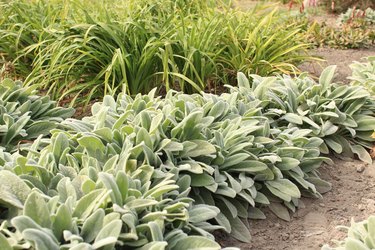
Lamb's ear, as sweet and soft as it may be, can be invasive, appearing in unexpected locations in your garden whether you have planted it or not. Lamb's ear (Stachys byzantina, USDA plant hardiness zones 4a through 9b) is a fuzzy plant with purple flower stalks and grayish-green leaves.
In the early spring and late fall, it can create a silvery coating on the ground that some find unappealing. Further, as the season goes on, it can get leggy and spread in undesirable locations. You can either pull the lamb's ear if you want to remove it completely or just prune off the unwanted or brown growth.
Video of the Day
Video of the Day
Pruning Lamb's Ear
Once lamb's ear is established in your garden, there is very little you need to do except to control its growth. This plant will die back to the ground in the winter. In the spring when the weather and the soil warm, the plant will send up soft green shoots. If you have not cleaned up the garden bed before winter, be sure to prune out any old lamb's ear stems from the previous season at this time, not only for the sake of aesthetics but to make room for the new growth to fully emerge. Cut these old, dead stems to the ground, taking care not to damage the roots of the plant itself. First, be sure to clean your garden shears to ensure that you are not spreading disease between plants.
As the season progresses, lamb's ear will typically send up a flower shoot topped by either pink or purple flowers. When these flowers fade, clip them off completely down to the base of their stem. This will encourage new flower growth.
Again, no real pruning is necessary, but if lamb's ear is taking over a garden bed, you can pull it up. Its roots are fairly shallow, and it is easily removed.
Caring for Lamb's Ear
Lamb's ear prefers somewhat dry, well-drained soil and can thrive in full sun as well as partial shade. It is susceptible to disease if it is overwatered, in particular, if you are irrigating from above so that the leaves get wet. If its stalk or leaves turn brown, it may be developing a fungus, so always water the soil under the plant and avoid getting water on the leaves.
In ideal conditions, it can be invasive, spreading via its stems that will send out roots at the nodes, creating new plants with their own root systems. In highly humid or rainy conditions, it is susceptible to root rot. Generally, the primary problem with lamb's ear is its tendency to spread throughout your garden, so it's not generally necessary to do anything at all to promote its growth.
As part of a regular garden fall cleanup, cut back your lamb's ear to the ground. It will send up new shoots in spring.